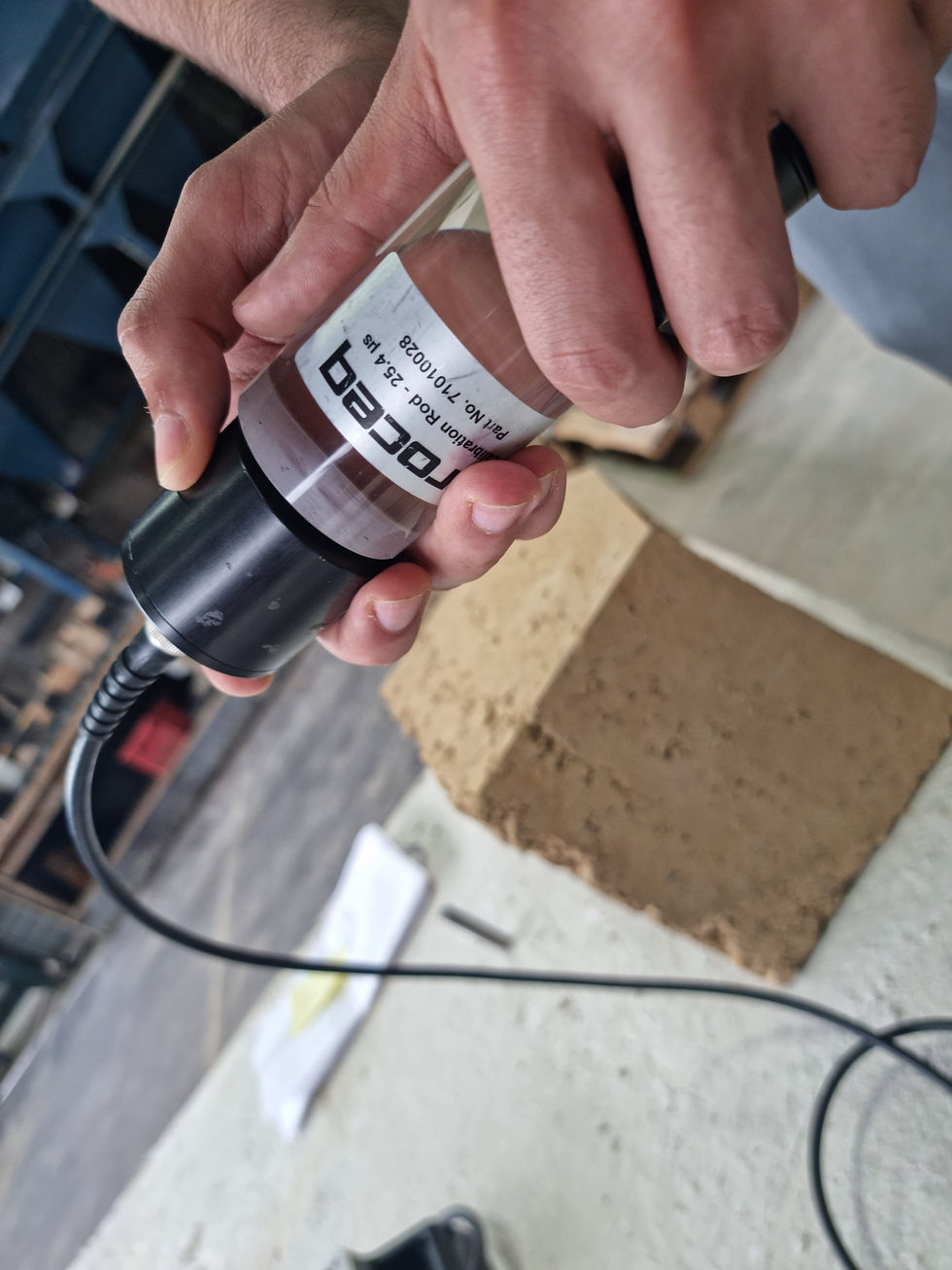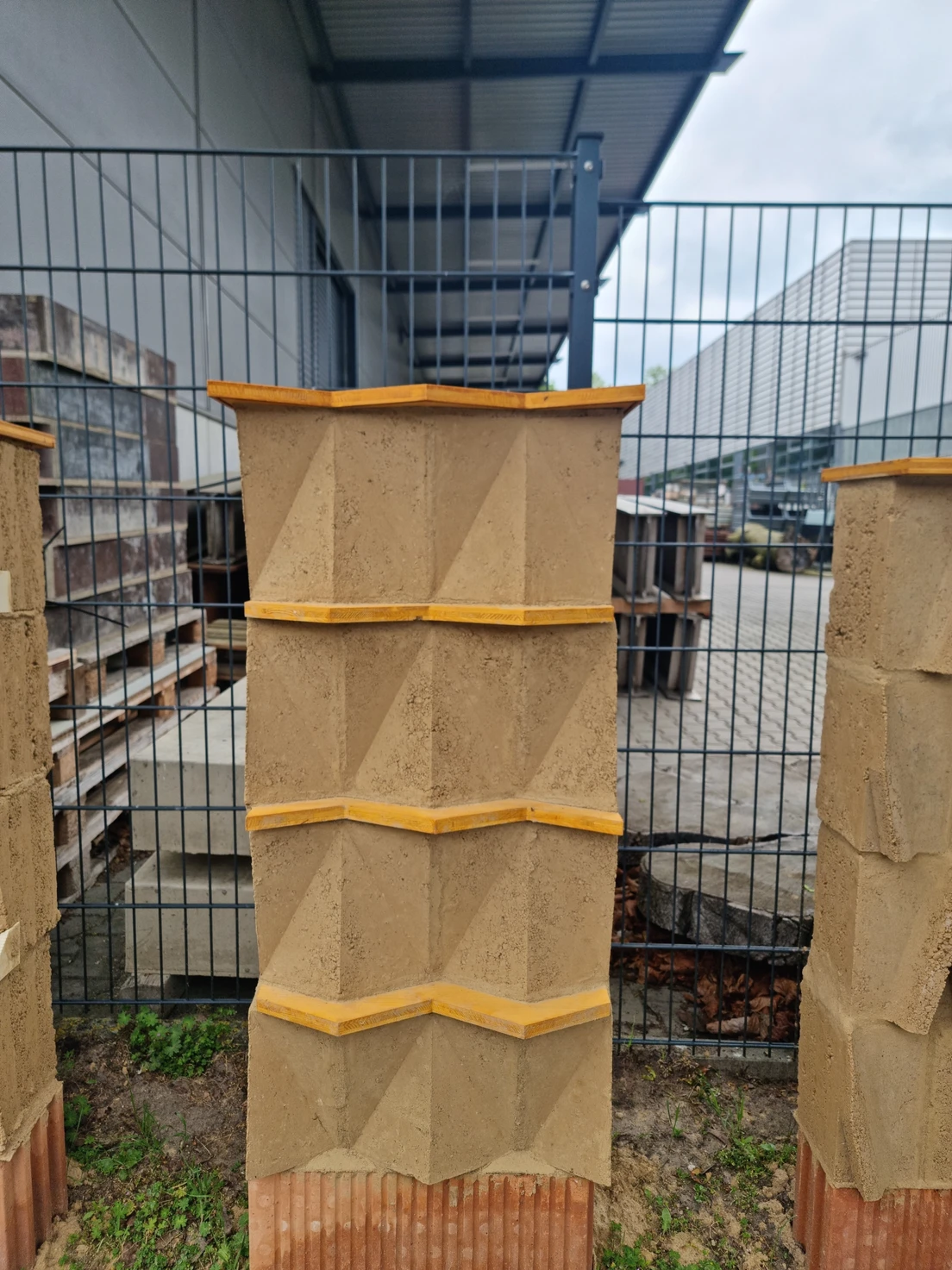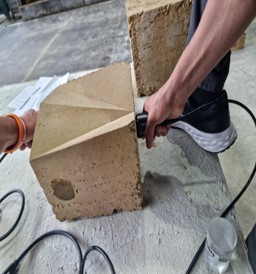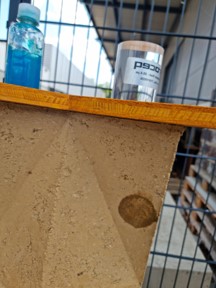Proceq Pundit Ultrasonic

After the Lehm.Workshop, I enrolled in the “Non-Destructive Testing for Building Diagnostics and Monitoring” course.
I hoped that it would also be possible to work with clay again in this course here.
We were lucky. Our professor found the idea interesting and encouraged us to implement it
Several research Themes were suggested to us, each theme to be carried out with number of Non-Destructive machines.
The ressearch Themes were originally generated for concrete and almost all devices were originally made for concrete. So, I wasn't sure which device would suit the chosen material (Clay).
Wenn Ultraschall auf ein Material trifft, verändert sich der Schall im Abhängigkeit von den physikalischen Eigenschaften des verwendeten Werkstoffs und seiner Ausrichtung - Vössing 2022

Luckily, Professor Algernon mentioned to us a PHD that is experimenting with wood.
Non-destructive testing of wood materials with air-coupled ultrasound - presented by M. Sc Konrand Josef Vössing
This paper deals with the question of the extent to which air-coupled ultrasound is suitable for the non-destructive testing of wood.
Although Vössing's work is about the wood, we will however try to use it as a guide for ourselves since we do not test concrete. We test clay.
This is a new level for me. The sad thing is that our time period is limited. Two months or 8 days between lectures and labor work.
Test Performed: Ultrasonic Pulse Velocity (UPV) testing is used to determine the integrity and quality of structural concrete or stone (up to 6 feet thick) by measuring the speed and attenuation of an ultrasonic wave passing through the element being tested. Areas with lower velocities typically have lower density and strength relative to high velocity areas. Data collected along multiple test paths can be used to create tomographic images of defects. Geräte, die von unserem Professor vorgeschlagen wurden :
Proceq Pundit Ultrasonic: Pulse Velocity, Pulse Echo
Schmidt Hammer
On Schmiedt Hammer
Dr Algernon had the opinion that we need to try number of test devices; Transmission and Puls Echo, in addition to that he suggested Schmidt Hammer.
Interesting is that we found out later that schmidt is a destructive testing device eventhough it was introduced to us as part of the Non-Destructiv tests.
It is in the case of concrete that the hammer almost harmlos was. After the test there were very small marks - barely seen- left on the concrete. I imagine that such a test on the rammed earth brick will leave thin but deep holes in the brick. Unfortunately We were asked not to deform the clay brick availabe to us in any shape, Hence an expierement with Schmidt is not applied.
Insgesamt können bei den Testverfahren drei Varianten unterschieden werden: eine zerstörende, eine teilzerstörende und eine zerstörungsfreie Prüfung (ZfP). Bei der Auswahl eines geeigneten Prüfverfahrens werden zerstörungsfreie Prüfungen bevorzugt, da es bei diesen Verfahren zu keiner Schädigung der Holzsubstanz kommt. Die beiden genannten Prüfverfahren gliedern sich nochmals in volumenorientierte Messmethoden wie zum Beispiel die Radar- und die Ultraschallprüfung, und lokale Messverfahren, wie die Bohrwiderstandsmessung und die Bohrkernentnahme. Erstere beinhalten das Scannen. vollständiger Flächen, wohingegen letztere nur Informationen zu einem Punkt liefern. Im Gegensatz zu teilzerstörenden Prüfverfahren, die meist auf mechanischen Tests beruhen, nutzt die ZfP üblicherweise elastische oder elektromagnetische Wellen Elastische Wellen werden beispielsweise in der Ultraschalltechnik verwendet, während elektromagnetische Wellen beim Radar zum Einsatz kommen. Um Abbildungen zu erzeugen, wird entweder der Sender über das Bauteil oder das Bauteil unter dem Sender hergeführt, während gleichzeitig die Signale aufgezeichnet werden. Die Wahl eines geeigneten Prüfverfahrens ist bis zu einem bestimmten Grad abhängig von der gewünschten Auflösung: Je kürzer die Wellenlänge, desto größer ist die Auflösung [Bucur 2003)
while the text here defines what is destructive and what is not depending on the technique used (Waves or mechanical). I want to add that destructive or not, depends on the technique used in the device and material being tested; Cocrete can treat Schmidt Hammer as non-Destructive meanwhile the same hammer can be deforming when used on clay
Proceq Pundit Ultrasonic : Pulse Velocity, Pulse Echo
Mohamed Abouelnaga, Mohamed Bou
Einfürhung:
Two main questions:
1 Do we get any comprehensible results when using ultrasound on clay?
2 Can we use ultrasound to measure the quality of clay?
The concept behind:
After storing the test specimens in different humid climates, tests were carried out to determine the compressive strength and deformation behavior of bricks and mortars in order to quantify the influence of RH relative humidity on strength and deformation properties.
The velocity of a pulse of compressional wave passing through clay depends on the tested Mateiral's properities (the better the denisty the higher the velocity) 2
Objects of Test
1- Two rammed earth bricks with apparent slight pounding diffference
2- A wall exposed to weathering
Prüfungsverfahren
Preparation - Basic preparations are common to each application. The distance (path length) between the transducers should be measured as accurately as possible (unless you are measuring in transmission time mode)
It is essential in all ultrasonic pulse tests to use some form of couplant between the faces of the transducers and the material under test. Failure to do so will result in a loss of signal due to inadequate acoustic coupling. The ultrasound couplant provided provides good coupling when used on concrete or other materials having smooth surfaces. Silicone grease, medium bearing grease or liquid soap may also be used to good effect. For rougher surfaces, a thick grease or petroleum jelly is recommend

Zeroing Transducer
Pundit Proseq should be zeroed on a regular basis and in particular if the transducer frequency is changed or if the cables are changed.

Enter the expected calibration value as it is marked on the calibration rod (G) Couple the transducers to the calibration rod using the ultrasound couplant (E) and press firmly together as shown
Methods of measurement: Direct, Semi-direct, Indirect

Direct Transmission: The optimum configuration with maximum signal level. The most accurate method of pulse velocity determination. Path length is measured from centre to centre of the transducers.

Semi-direct Transmission: Sen- sitivity is somewhere between the other two methods. Lower accuracy than the direct method. Path length is measured from centre to centre of the transducers.

Indirect Transmission: Signal level is only about 2-3% of signal level when using direct transmission. Path length is uncertain. Use the surface velocity mode or line scan to elimi- nate this uncertainty. Pulse velocity determined by this method may be lower than that from direct method by 5 20%. Where possible carry out a comparison measurement to determine this.
Test performed on rammed earth bricks stored in room Temperature
Direct reading
Indirect readinng
Test performed on the wall located outside

Conclusions and notes
Confirmation of the concept
After comparing the results of the test methods, it can be confirmed that the speed of a pulse of a pressure wave passing through clay depends on the properties of the tested material.
(The better the tightness, the higher the speed)
According to the results we collected, the speed slowed down in the second brick, which had relatively less density.
Results excluded and results adapted.
1 Do we get any comprehensible results at all when using ultrasound on clay?
When we start we were not actucally sure if we wil get outcome or any reliable numbers, since Ultraschall ist bei der ZFP von Lehm nicht einfach im Internet zu finden. After the expierement we have recorded numbers that were compareable. they were consistent. the results in this case repeated themself when we repeated the same steps. (Direct Messuares - Indirect Messuares) It is only in case of Semi-Direct Messuare that we started to see different results everytime even when the same test steps were repeated. (This reminds me ) This was one part that I could not understand, aber zu meinem Verstandnis müssten wir zumindest auch die einstellung von Geräte beartbeiten, so hat Dr Vössnig erwähnt in seiner Arbeit. This modification should be done so the Geräte will be fit for testing clay.

The second confusion is when we tried to apply the direct testing on two bricks beside eachother. (as shown in the picture). we got a neglicable numbers. The spead is almost not there. and for there we had two theories. Mohamed thinks that the device is not set to test distances as 50 Cm or more. I believe that the neglicable spead is an indication of a gap between the stones (I was part of the team who built the wall, I remeber that the area between stones were not equilly filled, there were quite few gaps )

- Transversalwellen Prüfkopf liefert verschiedene Werte für das gleiche Prüfobjekt As we tried to use the Puls Echo we were countrted with a consistent failure. we would measure the same spot one time and repeat on same spot several times. each time gives different numbers!
My assumption is, this happens because we needed first to adjust the setting of the device to fit witht the chrarctristic of clay which is different of the concrete chrarctersitic. a similar challenge was mentioned in the paper of Dr. Vössing as he had t modify the device to be able to do the testing on Wood instead of concrete. However it can be our mistake by not applying the steps of the test correctly. 2 Können wir mit Helfe Ultarschall dier Qualtität von Lehm bemessen ?
the two bricks were used as Quality refernce. The wall was our testing object.
No remarkable results were seen, as the period of the test with limited to 2 months, within which the wall kept its integrity.
Until the last day of the expierment, the wall maintained almost the same good condition. We needed more time for the wall to change its condtion due to the continus weathering, only then we might have had noticable differences in reading between the refernce stone and the wall.
To improve our work in the Future we will need to test more stones, to give more crediabilty to our results, to see if we can correct what we believe was a human mistake during the test. To see if we can find a mistake in what we believe was correctly done.
-We want to explore more the relation between Velocity and the quality of pounding the bricks. This can be done by intentionally Pound number of bricks differntly and then test them.
-Finished. Until the next expierment -
later on I had a question that I addressed to Dr. Philipp Hoppe The question was '' The mention of corrosion on the outside raised a question in my mind; We have studied wood and learned that it can be destroyed internally by insects for example.
Can clay construction be eroded from the inside if not by an insect, can it be caused by any other factors?
In other words, can the decomposition or destruction of Rammed Earth begin from the inside?'' The answer for the later questions as Dr. Philipp Hoppe wrote back : ''To my knowledge, earth construciton can only be destabilized (eroded) from the inside by moisture. So you always have to take care to avoid rising moisture (from the foot of the wall) or sinking in from the top of the wall.''


























Kommentare